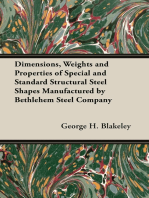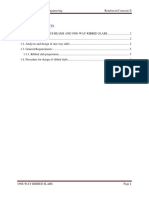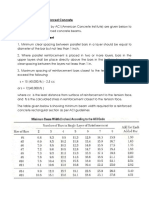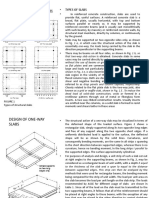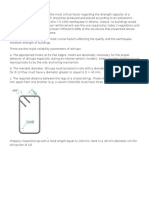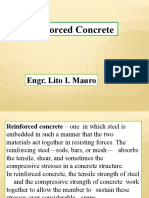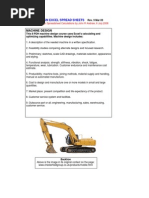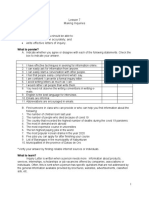Chapter 3
Chapter 3
Uploaded by
znabu asefaCopyright:
Available Formats
Chapter 3
Chapter 3
Uploaded by
znabu asefaCopyright
Available Formats
Share this document
Did you find this document useful?
Is this content inappropriate?
Copyright:
Available Formats
Chapter 3
Chapter 3
Uploaded by
znabu asefaCopyright:
Available Formats
CHAPTER 3: DESIGN OF SLABS
3.1. ANALYSIS AND DESIGN OF ONE-WAY SLAB SYSTEM
3.1.1. Introduction
In reinforced concrete construction, slabs are used to provide flat, useful surfaces. A reinforced
concrete slab is a broad, flat plate, usually horizontal, with top and bottom surfaces parallel or
nearly so. It may be supported by reinforced concrete beams (and is usually cast monolithically
with such beams), by masonry or reinforced concrete walls, by structural steel members, directly
by columns, or continuously by the ground. Slabs are surface plane elements that bear loads
transverse to their plain. Most of the times, slabs are statically indeterminate elements that
consequently redistribute the stresses applied to them. This ability makes them highly secure
against bending and shear failure.
Figure 3-1: Types of slabs based on their load transfer mechanism
1. One-way slabs: They are those either supported on the two out of four opposite sides or the
longer span to short span ratio is at least equal to 2.
2. Two-way slabs: They are those supported on all four sides and the longer span to short span
ratio is less than 2.
3. Cantilever slabs: They are those with a fixed support on only one out of four sides.
Reinforced Concrete Structures I Page 1
Figure 3-2: One-way slab supported by two beams
In the design and analysis of one way slab systems a 1m strip of slab along the load transverse
direction is considered as shown below.
Reinforced Concrete Structures I Page 2
3.1.2. Analysis of One-Way Slabs
For one-way slab sections with under both a negative and positive bending moment follows the
procedures analysis of rectangular sections discussed in chapter 2. The only exception is that the
width of the slab considered is 1m as previously pointed out.
3.1.3. Design of One-Way Slab
3.1.3.1. Concrete cover
The cover requirement for bond and durability are the same for that of beam requirements
discussed in chapter 2.
But for fire resistance the minimum dimension and cover requirements are given in EN 1992-1-
2:2004 table 5.8.
Reinforced Concrete Structures I Page 3
3.1.3.2. Minimum and Maximum area of reinforcement (Flexural reinforcement)
For the minimum and the maximum steel percentages in the main direction sections 2.5.4.3
(chapter 2) apply.
Secondary transverse reinforcement of not less than 20% of the principal reinforcement should
be provided in one way slabs. In areas near supports transverse reinforcement to principal top
bars is not necessary where there is no transverse bending moment.
The spacing of bars should not exceed Smax,slabs.
Note; The value of Smax,slabs for use in a Country may be found in its National Annex. The
recommended value is:
for the principal reinforcement, 3h ≤ 400 mm, where h is the total depth of the slab;
for the secondary reinforcement, 3.5h ≤ 450 mm.
In areas with concentrated loads or areas of maximum moment those provisions become
respectively:
for the principal reinforcement, 2h ≤ 250 mm
for the secondary reinforcement, 3h ≤ 400 mm.
3.1.3.3. Design of one-way slab
The same procedure carried out for design of singly reinforced rectangular beam sections
(2.6.5.2) can be adopted for one-way slabs but the above discussed points must be adopted in the
design procedures.
3.1.4. One-Way Ribbed Slabs
The same procedure carried out for design of singly reinforced rectangular beam sections, can be
adopted for one-way slabs Analysis and design of one-way ribbed slabs.
Long-span floors for relatively light live loads can be constructed as a series of closely spaced,
cast-in-place T-beams (or joists or ribs) with a cross section as shown in figure 3.3. The joists
span one way between beams. Most often, removable metal forms referred to as fillers or pans
are used to form the joists. Occasionally, joist floors are built by using clay-tile fillers, which
serve as forms for the concrete in the ribs that are left in place to serve as the celling.
Figure 3-3: Ribbed slab layout
Reinforced Concrete Structures I Page 4
Ribbed slabs are more economical than solid slabs for long spans with relatively light loads.
They may be constructed in a variety of ways as discussed above. Two principal methods of
construction are:
1. ribbed slabs without permanent blocks,
2. Ribbed slabs with permanent hollow or solid blocks.
Figure 3-4: (a) Ribbed slab; (b) ribbed slab with hollow blocks
Figure 3-5: Typical ribbed slab cross-section
Reinforced Concrete Structures I Page 5
3.1.4.1. General Requirements
The topping or concrete floor panels between ribs may or may not be considered to contribute to
the strength of the slab. The hollow or solid blocks may also be counted in assessing the strength
using rules given in the codes. The design of slabs with topping taken into account but without
permanent blocks is discussed as follows.
Ribbed Slab Proportions
The main requirements of proportions for ribbed slabs without permanent blocks are as follows:
1. The centers of ribs should not exceed 1.5 m;
2. The depth of ribs excluding topping should not exceed four times their average width;
3. The minimum rib width should be determined by consideration of cover, bar spacing and fire
resistance. Referring in the code, the minimum rib width is 125 mm;
4. The thickness of structural topping or flange should not be less than 50 mm or one tenth of the
clear distance between ribs.
3.1.4.2. Procedure for Design of Ribbed Slabs
1. Shear forces and moments: Shear forces and moments for continuous slabs can be obtained
by elastic analysis.
2. Design for moment and moment reinforcement: The mid-span section is designed as a T-
beam with flange width equal to the distance between ribs. The support section is designed as a
rectangular beam. The slab may be made solid near the support to increase shear resistance.
Moment reinforcement consisting of one or more bars is provided in the top and bottom of the
ribs. If appropriate, bars can be curtailed in a similar way to bars in solid slabs
3. Shear resistance and shear reinforcement
4. Reinforcement in the topping: Mesh reinforcement with a cross-sectional area of not less than
0.12% of the area of the topping in each direction should be provided. The spacing of wires
should not exceed one-half the center-to-center distance of the ribs. The mesh is placed in the
center of the topping and requirements of cover in the code should be satisfied. If the ribs are
widely spaced the topping may need to be designed for moment and shear as a continuous one-
way slab between ribs.
3.2. ANALYSIS AND DESIGN OF TWO-WAY SOLID SLABS
3.2.1. Introduction
Slabs may be supported on two opposite sides only, as shown in Figure 3-6a, in which case the
structural action of the slab is essentially one-way, the loads being carried by the slab in the
direction perpendicular to the supporting beams. There may be beams on all four sides, as shown
in Figure 3-6b, so that two-way slab action is obtained. Intermediate beams, as shown in Figure
3-6c, may be provided. If the ratio of length to width of one slab panel is larger than about 2,
most of the load is carried in the short direction to the supporting beams and one-way action is
obtained in effect, even though supports are provided on all sides. Concrete slabs in some cases
may be carried directly by columns, as shown in Figure 3-6d, without the use of beams or
girders. Such slabs are described as flat plates and are commonly used where spans are not large
and loads not particularly heavy. Flat slab construction, shown in Figure 3-6e is also beamless
Reinforced Concrete Structures I Page 6
but incorporates a thickened slab region in the vicinity of the column and often employs flared
column tops. Both are devices to reduce stresses due to shear and negative bending around the
columns. They are referred to as drop panels and column capitals, respectively. Closely related to
the flat plate slab is the two-way joist, also known as a grid or waffle slab, shown in Figure 3-6f.
To reduce the dead load of solid-slab construction, voids are formed in a rectilinear pattern
through use of metal or fiberglass form inserts. A two way ribbed construction results. Usually
inserts are omitted near the columns, so a solid slab is formed to resist moments and shear better
in these areas.
Figure 3-6: Types of Structural Slabs
Reinforced Concrete Structures I Page 7
3.2.2. Behavior of Two-Way Edge-Supported Slabs
In many cases, rectangular slabs are of such proportions and are supported in such a way that
two-way action results. When loaded, such slabs bend into a dished surface rather than a
cylindrical one. This means that at any point the slab is curved in both principal directions, and
since bending moments are proportional to curvatures, moments also exist in both directions. To
resist these moments, the slab must be reinforced in both directions, by at least two layers of bars
perpendicular, respectively, to two pairs of edges. The slab must be designed to take a
proportionate share of the load in each direction.
The simplest type of two-way slab action is that represented by Figure 3-7b, where the slab, or
slab panel, is supported along its four edges by relatively deep, stiff, monolithic concrete beams
or by walls or steel girders. If the concrete edge beams are shallow or are omitted altogether, as
they are for flat plates and flat slabs, deformation of the floor system along the column lines
significantly alters the distribution of moments itself. The present discussion pertains to the
former type, in which edge supports are stiff enough to be considered unyielding.
Such a slab is shown in Figure 3-7 to visualize its flexural performance; it is convenient to think
of it as consisting of two sets of parallel strips, in each of the two directions, intersecting each
other. Evidently, part of the load is carried by one set and transmitted to one pair of edge
supports, and the remainder by the other.
Figure 3-7: Two-way slab on simple edge supports: (a) bending of center strips of slab; (b)
grid model of slab
Figure 3-7a shows the two center strips of a rectangular plate with short span 𝑙𝑎 and long span 𝑙𝑏 .
If the uniform load is q per square meter of slab, each of the two strips acts approximately as a
simple beam, uniformly loaded by its share of q, because these imaginary strips actually are part
Reinforced Concrete Structures I Page 8
of the same monolithic slab; their deflections at the intersection point must be the same. Equating
the center deflections of the short and long strips gives
5𝑞𝑎 𝑙𝑎4 5𝑞𝑏 𝑙𝑏4
=
384𝐸𝐼 384𝐸𝐼
Where 𝑞𝑎 is the share of the load 𝑞 carried in the short direction and 𝑞𝑏 is the share of the load 𝑞
carried in the long direction. Consequently,
𝑞𝑎 𝑙𝑏4
=
𝑞𝑏 𝑙𝑎4
One sees that the larger share of the load is carried in the short direction, the ratio of the two
portions of the total load being inversely proportional to the fourth power of the ratio of the
spans.
This result is approximate because the actual behavior of a slab is more complex than that of the
two intersecting strips. An understanding of the behavior of the slab itself can be gained from
Figure 3-7b, which shows a slab model consisting of two sets of three strips each. It is seen that
the two central strips 𝑠1 and 𝑙1 bend in a manner similar to that shown in Figure 3-7a. The outer
strips 𝑠2 and 𝑙2 , however, are not only bent but also twisted. Consider, for instance, one of the
intersections of 𝑠2 and 𝑙2 . It is seen that at the intersection the exterior edge of strip 𝑙2 is at higher
elevation than the interior edge, while at the nearby end of strip 𝑙2 both edges are at the same
elevation; the strip is twisted. This twisting result in torsional stresses and torsional moments that
are seen to be most pronounced near the corners. Consequently, the total load on the slab is
carried not only by the bending moments in two directions but also by the twisting moments. For
this reason, bending moments in elastic slabs are smaller than would be computed for sets of
unconnected strips loaded by 𝑞𝑎 and 𝑞𝑏 . For instance, for a simply supported square slab,𝑞𝑎 =
𝑞𝑏 = 𝑞/2. If only bending were present, the maximum moment in each strip would be
𝑞/2 𝑙 2
= 0.0625𝑞𝑙 2
8
The exact theory of bending of elastic plates shows that actually the maximum moment in such a
square slab is only 0.048𝑞𝑙 2 , so that in this case the twisting moments relieve the bending
moments by about 25 percent.
The largest moments occurs where the curvature is sharpest. Figure 3-7b shows this to be the
case at midspan of the short strips 𝑠1 . Suppose the load is increased until this location is
overstressed, so that the steel at the middle of strip 𝑠1 is yielding. If the strip were an isolated
beam, it would now fail. Considering the slab as a whole, however, one sees that no immediate
failure will occur.
The neighboring strips (those parallel as well as those perpendicular to 𝑠1 ), being actually
monolithic with it, will take over any additional load that strip 𝑠1 can no longer carry until they,
in turn, start yielding. This inelastic redistribution will continue until in a rather large area in the
central portion of the slab all the steel in both directions is yielding. Only then will the entire slab
fail. From this reasoning, which is confirmed by tests, it follows that slabs need not be designed
for the absolute maximum moment in each of the two directions (such as 0.048𝑞𝑙 2 in the
Reinforced Concrete Structures I Page 9
example given in the previous paragraph), but only for a smaller average moment in each of the
two directions in the central portion of the slab. For instance, one of the several analytical
methods in general use permits a square slab to be designed for a moment of 0.036𝑞𝑙 2 . By
comparison with the actual elastic maximum moment 0.048𝑞𝑙 2 , it is seen that, owing to inelastic
redistribution, a moment reduction of 25 percent is provided.
The largest moment in the slab occurs at midspan of the short strip 𝑠1 of Figure 3-7b. It is
evident that the curvature, and hence the moment, in the short strip 𝑠2 is less than at the
corresponding location of strip 𝑠1 . Consequently, a variation of short-span moment occurs in the
long direction of the span. This variation of short-span moment occurs in the long direction of
the span. This variation is shown qualitatively in Figure 3-8. The short-span moment diagram in
Figure 3-8a is valid along the strip 1-1. Elsewhere, the maximum-moment value is less, as
shown. Other moment ordinates are reduced proportionately. Similarly, the long-span moment
diagram in Figure 3-8 applies only at the longitudinal centerline of the slab; elsewhere, ordinates
are reduced according to the variation shown. These variations in maximum moment across the
width and length of a rectangular slab are accounted for in an approximate way in most practical
design methods by designing for a reduced moment in the outer quarters of the slab span in each
direction.
It should be noted that only slabs with side ratios less than about 2 needs to be treated as two-
way slabs. From Equation above, it is seen that for a slab of this proportion, the share of the load
carried in the long direction is only on the order of one-sixteenth of that in the short direction.
Such a slab acts almost as if it were spanning in the short direction only. Consequently,
rectangular slab panels with an aspect ratio of 2 or more may be reinforced for one-way action,
with the main steel perpendicular to the long edges.
Figure 3-8: Moments and moment variations in a uniformly loaded slab with simple
supports on four sides
Reinforced Concrete Structures I Page 10
Consistent with the assumptions of the analysis of two-way edge supported slabs, the main
flexural reinforcement is placed in an orthogonal pattern, with reinforcing bars parallel and
perpendicular to the supported edges. As the positive steel is placed in two layers, the effective
depth d for the upper layer is smaller than that for the lower layer by one bar diameter. Because
the moments in the long direction are the smaller ones, it is economical to place the steel in that
direction on top of the bars in the short direction. The stacking problem does not exist for
negative reinforcement perpendicular to the supporting edge beams except at the corners, where
moments are small.
The twisting moments discussed earlier are usually of consequences only at exterior corners of a
two-way slab system, where they tend to crack the slab at the bottom along the panel diagonal,
and at the top perpendicular to the panel diagonal. Special reinforcement should be provided at
exterior corners in both the bottom and top of the slab, for a distance in each direction from the
corner in both the bottom and top of the slab, for a distance in each direction from the corner
equal to one-fifth the longer span of the corner panel, as shown in Figure 3-9. The reinforcement
at the top of the slab should be parallel to the diagonal from the corner, while that at the bottom
should be perpendicular to the diagonal.
Figure 3-9: Special reinforcement at exterior corners of a beam- supported two-way slab
3.2.3. Design of Two – Way Edge Supported Slabs Using Yield-Line Coefficients
For rectangular slabs with standard edge conditions and subject to uniformly distributed loads,
normally the bending moments are obtained using tabulated coefficients. Such coefficients are
provided later in this section.
3.2.3.1. Simply supported slabs
When simply-supported slabs do not have adequate provision to resist torsion at the corners, and
to prevent the corners from lifting, the maximum moments per unit width are given by the
following equations:
Reinforced Concrete Structures I Page 11
𝑀𝑠𝑥 = 𝛼𝑠𝑥 𝑞𝑙𝑥2
𝑀𝑠𝑦 = 𝛼𝑠𝑦 𝑞𝑙𝑥2
Note: Values for 𝛼𝑠𝑥 and 𝛼𝑠𝑦 are given in Table 3-1.
Where:
𝑀𝑠𝑥 Maximum design ultimate moments either over supports or at mid-span on strips
of unit width and span 𝑙𝑥
𝑀𝑠𝑦 Maximum design ultimate moments either over supports or at mid-span on strips
of unit width and span 𝑙𝑦
𝛼𝑠𝑥 and 𝛼𝑠𝑦 Moment coefficients
𝑞 Total design ultimate load per unit area
𝑙𝑥 Length of shorter side
𝑙𝑦 Length of longer side
The values in Table 3-1are derived from the following equations:
4
𝑙𝑦 /𝑙𝑥
𝛼𝑠𝑥 = 4
8(1 + 𝑙𝑦 /𝑙𝑥 )
2
𝑙𝑦 /𝑙𝑥
𝛼𝑠𝑦 = 4
8(1 + 𝑙𝑦 /𝑙𝑥 )
Table 3-1: Bending moment coefficients for slabs spanning in two directions at right angles,
simply supported on four sides
𝑙𝑦 /𝑙𝑥 1.0 1.1 1.2 1.3 1.4 1.5 1.75 2.0
𝛼𝑠𝑥 0.062 0.074 0.084 0.093 0.099 0.104 0.113 0.118
𝛼𝑠𝑦 0.062 0.061 0.059 0.055 0.051 0.046 0.037 0.029
3.2.3.2. Rectangular panels with restrained edges
In slabs where the corners are prevented from lifting, and provision for torsion is made, the
maximum design moments per unit width are given by the following equations.
𝑀𝑠𝑥 = 𝛽𝑠𝑥 𝑞𝑙𝑥2
𝑀𝑠𝑦 = 𝛽𝑠𝑦 𝑞𝑙𝑥2
Note: Values of 𝛽𝑠𝑥 and 𝛽𝑠𝑦 are given in Table 3-2
Where:
𝛽𝑠𝑥 and 𝛽𝑠𝑦 Moment coefficients
The above equations and the coefficients in Table 3-2 may be derived from the following
equations:
𝛽𝑦 = (24 + 2𝑁𝑑 + 1.5𝑁𝑑2 )/1000
2 𝑙𝑥
𝛾 = [3 − 18 𝛽𝑦 + 𝛽 1 + 𝛽𝑦 + 𝛽2 ]
9 𝑙𝑦
Reinforced Concrete Structures I Page 12
𝛾= 𝛽𝑥 + 𝛽3 + 𝛽𝑥 + 𝛽4
Where:
𝑁𝑑 Number of discontinuous edges (0 ≤ 𝑁 ≤ 4)
𝑀𝑠𝑦 Maximum design ultimate moments either over supports or at mid-span on
strips of unit width and span 𝑙𝑦
𝛽1 and 𝛽2 Hogging moments, per unit width, over the shorter edges divided by 𝑞𝑙𝑥2
𝛽3 and 𝛽4 Hogging moments, per unit width, over the longer edges divided by 𝑞𝑙𝑥2
𝑙𝑥 Length of shorter side
𝑙𝑦 Length of longer side
Note: 𝛽1 and 𝛽2 take values of 4/3𝛽𝑦 for continuous edges or zero for discontinuous edges.
𝛽3 and 𝛽4 take values of 4/3𝛽𝑥 for continuous edges or zero for discontinuous edges.
The conditions in which the equations may be used for continuous slabs only are as follows.
a) The characteristic dead and imposed loads on adjacent panels are approximately the same as
on the panel being considered.
b) The span of adjacent panels in the direction perpendicular to the line of the common support is
approximately the same as the span of the panel considered in that direction.
Table 3-2: Bending moment coefficients for rectangular panels supported on four sides
with provision for torsion at corners
Type of Panel and Short span coefficients, 𝛽𝑠𝑥 Long span
moments considered Values of 𝑙𝑦 /𝑙𝑥 coefficients,
𝛽𝑠𝑥 for all
1.0 1.1 1.2 1.3 1.4 1.5 1.75 2.0 values of 𝑙𝑦 /𝑙𝑥
Interior Panels
Negative moment at 0.031 0.037 0.042 0.046 0.050 0.053 0.059 0.063 0.032
continuous edge
Positive moment at mid- 0.024 0.028 0.032 0.035 0.037 0.040 0.044 0.048 0.024
span
One short edge
discontinuous
Negative moment at 0.039 0.044 0.048 0.052 0.055 0.058 0.063 0.067 0.037
continuous edge
Positive moment at 0.029 0.033 0.036 0.039 0.041 0.043 0.047 0.050 0.028
mid-span
One long edge
discontinuous
Negative moment at 0.039 0.049 0.056 0.063 0.068 0.073 0.082 0.089 0.037
continuous edge
Positive moment at 0.030 0.036 0.042 0.047 0.051 0.055 0.062 0.067 0.028
mid-span
Reinforced Concrete Structures I Page 13
Two adjacent edges
discontinuous
Negative moment at 0.047 0.056 0.063 0.069 0.074 0.078 0.087 0.093 0.045
continuous edge
Positive moment at mid- 0.036 0.042 0.047 0.051 0.055 0.059 0.065 0.070 0.034
span
Two short edges
discontinuous
Negative moment at 0.046 0.050 0.054 0.057 0.060 0.062 0.067 0.070 -
continuous edge
Positive moment at mid-
span 0.034 0.038 0.040 0.043 0.045 0.047 0.050 0.053 0.034
Two long edges
discontinuous
Negative moment at - -- - - - - - - 0.045
continuous edge
Positive moment at mid- 0.034 0.046 0.056 0.065 0.072 0.078 0.091 0.100 0.034
span
Three edges
discontinuous (one long
edge continuous)
Negative moment at 0.057 0.065 0.071 0.076 0.081 0.084 0.092 0.098 -
continuous edge
Positive moment at mid- 0.043 0.048 0.053 0.057 0.060 0.063 0.069 0.074 0.044
span
Three edges
discontinuous (one short
edge continuous)
Negative moment at - - - - - - - - 0.058
continuous edge
Positive moment at mid- 0.042 0.054 0.063 0.071 0.078 0.084 0.096 0.105 0.044
span
Four edges
discontinuous
Positive moment at mid- 0.055 0.065 0.074 0.081 0.087 0.092 0.103 0.111 0.056
span
Reinforced Concrete Structures I Page 14
Figure 3-10: Explanation of the derivation of the coefficient of Table 3-2
3.2.3.3. Restrained slab with unequal conditions at adjacent panels
𝑀−1 and 𝑀−2 are the support moments for panels 1 and 2, respectively, and 𝑀+1 and 𝑀+2 are the
span moments for panels 1 and 2, respectively.
In some cases, the bending moments at a common support, obtained by considering the two
adjacent panels in isolation, may differ significantly (say by 10%), because of the differing edge
condition at the far supports or differing span lengths or loading.
Consider panels 1 and 2 in Figure 3-11. As the support on grid A for panel 1 is discontinuous and
support on grid C for panel 2 is continuous, the moments for panels 1 and 2 for the support on
grid C for panel 2 is continuous, the moments for panels 1 and 2 for the support on grid B could
be significantly different. In these circumstances, the slab may be reinforced throughout for the
worst case span and support moments. However, this might be uneconomic in some cases. In
such cases, the following distribution procedure may be used:
1) Obtain the support moments for panels 1 and 2 from Table. Treating 𝑀−1 and 𝑀−2 as
fixed end moments, the moments may be distributed in proportion to the stiffnesses of
′
span 𝑙𝑥 in panels 1 and 2. Thus, a revised bending moments 𝑀−𝐵 may be obtained for
support over B.
2) The span moments in panels 1 and 2 should be recalculated as follows:
(Note that this assumes that the final moment over C is 𝑀−2 )
3) For curtailment of reinforcement, the point of contra-flexure may be obtained by assuming a
parabolic distribution of moments in each panel.
Reinforced Concrete Structures I Page 15
Figure 3-11: Two-way spanning slabs: unequal edge condition in adjacent panels
Figure 3-12: Division of slab into middle and edge strip
Reinforced Concrete Structures I Page 16
3.2.3.4. Loads on supporting beams
The design loads on beams supporting solid slabs spanning in two directions at right angles and
supporting uniformly distributed loads may be assessed from the following equations:
𝑣𝑠𝑦 = 𝛽𝑣𝑦 𝑞𝑙𝑥
𝑣𝑠𝑥 = 𝛽𝑣𝑥 𝑞𝑙𝑥
Where:
𝑣𝑠𝑦 Design end shear on strips of unit width and span 𝑙𝑦 and considered to act over the
middle three-quarters of the edge.
𝑣𝑠𝑥 Design end shear on strips of unit width and span 𝑙𝑥 and considered to act over the
middle three-quarters of the edge.
Where design ultimate support moments are used which differ substantially from those that
would be assessed from Table, adjustment of the values given in Table may be necessary. The
assumed distribution of the load on a supporting beam is shown in Figure 3-13.
Figure 3-13: Distribution of load on a beam supporting a two-way spanning slabs
Table 3-3: Shear force coefficients for uniformly loaded rectangular panels supported on
four sides with provision for torsion at corners
Type of Panel and 𝛽𝑣𝑥 for values of 𝑙𝑦 /𝑙𝑥
location 𝛽𝑣𝑦
1.0 1.1 1.2 1.3 1.4 1.5 1.75 2.0
Four edges continuous
Continuous edge 0.33 0.36 0.39 0.41 0.43 0.45 0.48 0.50 0.33
One short edge
discontinuous
Continuous edge 0.36 0.39 0.42 0.44 0.45 0.47 0.50 0.52 0.36
Discontinuous edge - - - - - - - - 0.24
One long edge
discontinuous
Continuous edge 0.36 0.40 0.44 0.47 0.49 0.51 0.55 0.59 0.36
Discontinuous edge 0.24 0.27 0.29 0.31 0.32 0.34 0.36 0.38 -
Reinforced Concrete Structures I Page 17
Two adjacent edges
discontinuous
Continuous edge 0.40 0.44 0.47 0.50 0.52 0.54 0.57 0.60 0.40
Discontinuous edge 0.26 0.29 0.31 0.33 0.34 0.35 0.38 0.40 0.26
Two short edges
discontinuous
Continuous edge 0.40 0.43 0.45 0.47 0.48 0.49 0.52 0.54 -
Discontinuous edge - - - - - - - - 0.26
Two long edges
discontinuous
Continuous edge - - - - - - - - 0.40
Discontinuous edge 0.26 0.30 0.33 0.36 0.38 0.40 0.44 0.47 -
Three edges
discontinuous (one long
edge discontinuous)
Continuous edge 0.45 0.48 0.51 0.53 0.55 0.57 0.60 0.63 -
Discontinuous edge 0.30 0.32 0.34 0.35 0.36 0.37 0.39 0.41 0.29
Three edges
discontinuous (one short
edge discontinuous)
Continuous edge - - - - - - - - 0.45
Discontinuous edge 0.29 0.33 0.36 0.38 0.40 0.42 0.45 0.48 0.30
Four edges discontinuous
Discontinuous edge 0.33 0.36 0.39 0.41 0.43 0.45 0.48 0.50 0.33
3.2.4. Design for Shear
It is not usual for a slab to contain shear reinforcement; therefore it is only necessary to ensure
that the concrete shear stress capacity without shear reinforcement is more than applied shear
stress.
Reinforced Concrete Structures I Page 18
You might also like
- Dimensions, Weights and Properties of Special and Standard Structural Steel Shapes Manufactured by Bethlehem Steel CompanyFrom EverandDimensions, Weights and Properties of Special and Standard Structural Steel Shapes Manufactured by Bethlehem Steel CompanyNo ratings yet
- 4.0 Slab Introduction & Design of One-way Slab-1No ratings yet4.0 Slab Introduction & Design of One-way Slab-124 pages
- Unit-I - Limit State Method Concept and Design of Beams: 1. MaterialsNo ratings yetUnit-I - Limit State Method Concept and Design of Beams: 1. Materials7 pages
- Slabs Are Plate Elements Forming Floors andNo ratings yetSlabs Are Plate Elements Forming Floors and5 pages
- Chapter 2. Analysis and Design of One-Way Ribbed Slabs: Figure 2-1 - Ribbed Slab LayoutNo ratings yetChapter 2. Analysis and Design of One-Way Ribbed Slabs: Figure 2-1 - Ribbed Slab Layout3 pages
- (LECT-21,22) Prestressed Concrete SlabsNo ratings yet(LECT-21,22) Prestressed Concrete Slabs22 pages
- Design of Structures RC Elements and Their CaharacteristicsNo ratings yetDesign of Structures RC Elements and Their Caharacteristics29 pages
- Reinforced 20concrete 20slabs 130628043040 Phpapp01No ratings yetReinforced 20concrete 20slabs 130628043040 Phpapp0130 pages
- Design of Rectangular Reinforced Concrete BeamNo ratings yetDesign of Rectangular Reinforced Concrete Beam7 pages
- ASTLTIMD. Module 5a. Design of Steel BeamsNo ratings yetASTLTIMD. Module 5a. Design of Steel Beams7 pages
- Composite Structures of Steel and Concrete: Beams, Slabs, Columns and Frames for BuildingsFrom EverandComposite Structures of Steel and Concrete: Beams, Slabs, Columns and Frames for BuildingsNo ratings yet
- A Short Guide to the Types and Details of Constructing a Suspension Bridge - Including Various Arrangements of Suspension Spans, Methods of Vertical Stiffening and Wire Cables Versus Eyebar ChainsFrom EverandA Short Guide to the Types and Details of Constructing a Suspension Bridge - Including Various Arrangements of Suspension Spans, Methods of Vertical Stiffening and Wire Cables Versus Eyebar ChainsNo ratings yet
- Strength Of Beams, Floor And Roofs - Including Directions For Designing And Detailing Roof Trusses, With Criticism Of Various Forms Of Timber ConstructionFrom EverandStrength Of Beams, Floor And Roofs - Including Directions For Designing And Detailing Roof Trusses, With Criticism Of Various Forms Of Timber ConstructionNo ratings yet
- Consignment Receipt Note (CRN) : Signature Not VerifiedNo ratings yetConsignment Receipt Note (CRN) : Signature Not Verified1 page
- SOB-Macro-V8 0_Operation_Manual_w01-en-ANo ratings yetSOB-Macro-V8 0_Operation_Manual_w01-en-A14 pages
- PDF Copa Lesson Plan Sem1 in Doc File DLNo ratings yetPDF Copa Lesson Plan Sem1 in Doc File DL119 pages
- Designof Power Driven Dough Mixing MachineNo ratings yetDesignof Power Driven Dough Mixing Machine5 pages
- Blossom Pătė Borsenio Cura Vergara Fesib Study 1No ratings yetBlossom Pătė Borsenio Cura Vergara Fesib Study 128 pages
- Readiness, Barriers and Potential Strenght of Nursing in Implementing Evidence-Based PracticeNo ratings yetReadiness, Barriers and Potential Strenght of Nursing in Implementing Evidence-Based Practice9 pages
- Risk-Neutral Probabilities Explained - Nicolas GisigerNo ratings yetRisk-Neutral Probabilities Explained - Nicolas Gisiger27 pages
- Correspondence: Enteric Involvement in Hospitalised Patients With COVID-19 Outside WuhanNo ratings yetCorrespondence: Enteric Involvement in Hospitalised Patients With COVID-19 Outside Wuhan2 pages
- Sika Viscocrete-5: High Performance Superplasticiser Concrete AdmixtureNo ratings yetSika Viscocrete-5: High Performance Superplasticiser Concrete Admixture2 pages
- The Financial Tap - Top 10 Trading RulesNo ratings yetThe Financial Tap - Top 10 Trading Rules3 pages
- VS-616G5 Series (Revision F) Programming ManualNo ratings yetVS-616G5 Series (Revision F) Programming Manual162 pages
- Computer Aided Instruction and Automated Online Examination-Noe CalmorinNo ratings yetComputer Aided Instruction and Automated Online Examination-Noe Calmorin11 pages
- Reinforced Concrete Buildings: Behavior and DesignFrom EverandReinforced Concrete Buildings: Behavior and Design
- Dimensions, Weights and Properties of Special and Standard Structural Steel Shapes Manufactured by Bethlehem Steel CompanyFrom EverandDimensions, Weights and Properties of Special and Standard Structural Steel Shapes Manufactured by Bethlehem Steel Company
- Unit-I - Limit State Method Concept and Design of Beams: 1. MaterialsUnit-I - Limit State Method Concept and Design of Beams: 1. Materials
- Chapter 2. Analysis and Design of One-Way Ribbed Slabs: Figure 2-1 - Ribbed Slab LayoutChapter 2. Analysis and Design of One-Way Ribbed Slabs: Figure 2-1 - Ribbed Slab Layout
- Design of Structures RC Elements and Their CaharacteristicsDesign of Structures RC Elements and Their Caharacteristics
- Reinforced 20concrete 20slabs 130628043040 Phpapp01Reinforced 20concrete 20slabs 130628043040 Phpapp01
- Composite Structures of Steel and Concrete: Beams, Slabs, Columns and Frames for BuildingsFrom EverandComposite Structures of Steel and Concrete: Beams, Slabs, Columns and Frames for Buildings
- A Short Guide to the Types and Details of Constructing a Suspension Bridge - Including Various Arrangements of Suspension Spans, Methods of Vertical Stiffening and Wire Cables Versus Eyebar ChainsFrom EverandA Short Guide to the Types and Details of Constructing a Suspension Bridge - Including Various Arrangements of Suspension Spans, Methods of Vertical Stiffening and Wire Cables Versus Eyebar Chains
- Strength Of Beams, Floor And Roofs - Including Directions For Designing And Detailing Roof Trusses, With Criticism Of Various Forms Of Timber ConstructionFrom EverandStrength Of Beams, Floor And Roofs - Including Directions For Designing And Detailing Roof Trusses, With Criticism Of Various Forms Of Timber Construction
- Consignment Receipt Note (CRN) : Signature Not VerifiedConsignment Receipt Note (CRN) : Signature Not Verified
- Readiness, Barriers and Potential Strenght of Nursing in Implementing Evidence-Based PracticeReadiness, Barriers and Potential Strenght of Nursing in Implementing Evidence-Based Practice
- Risk-Neutral Probabilities Explained - Nicolas GisigerRisk-Neutral Probabilities Explained - Nicolas Gisiger
- Correspondence: Enteric Involvement in Hospitalised Patients With COVID-19 Outside WuhanCorrespondence: Enteric Involvement in Hospitalised Patients With COVID-19 Outside Wuhan
- Sika Viscocrete-5: High Performance Superplasticiser Concrete AdmixtureSika Viscocrete-5: High Performance Superplasticiser Concrete Admixture
- Computer Aided Instruction and Automated Online Examination-Noe CalmorinComputer Aided Instruction and Automated Online Examination-Noe Calmorin

